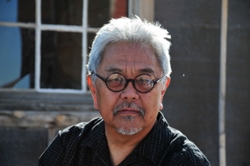On Jan. 23, Roger Shimomura spoke to the Willamette community about his life as an artist and a Japanese-American man.
His lecture was included in Willamette’s 2015 celebration of Martin Luther King, Jr., “Life Interrupted: A Look at Displaced Communities.”
For Shimomura, his art is both about the preconceptions people have about him and about his journey to understand his own identity.
“It’s the idea that you’re not quite as American as your white counterpart,” Shimomura says about the stereotypes portrayed in his artwork. “You’re always going to be a little different.”
Uprooted From Home
When he was 3 years old, Shimomura and his family, like thousands of other Japanese Americans, were uprooted from their home and interned in camps across the western half of the United States. Shimomura’s experiences and those of his grandmother — who documented her story in a series of diaries — inform much of his early work.
One such painting, from his “Diary: Minidoka” series of 1976, features his kimono-clad grandmother hearing what she called in her diary the “dreamlike news” of the attack on Pearl Harbor.
“My wife at the time felt that I was really selling out, that I was perpetuating Japanese stereotypes,” the artist says. “She said, ‘You know, white people all think that we come home from work and draw the shades and put on kimonos and eat with chopsticks. You’re perpetuating that idea by putting these people in kimonos.’
“But as I said earlier, the reason for doing that was to try to get this work seen by the public, so that eventually we could get to the discussion of the internment. But if I did it any other way, they simply would never be seen.”
Addressing Stereotypes
Shimomura continued working in the medium of stereotypes, combining cartoonish depictions of Japanese people — often taken from actual American literature and advertisements — with self-portraiture and American Pop art.
His piece, “A Jap’s a Jap” (2000), for instance, features an outlandish Japanese caricature offering a bouquet to Minnie Mouse.
“I did this with the idea that this is how a lot of Japanese Americans feel,” Shimomura says. “They’re made to feel as though they were the Japanese enemy, that they’re the immigrants. When you juxtapose that next to the wonderful Miss Minnie Mouse, it becomes apparent that obviously this is not a relationship that’s going to work out.”
Shimomura’s recent series, which he calls a “collection of stereotypes,” is a tongue-in-cheek nod to the way people perceive him as a Japanese American. It includes works such as “135 Misspellings of my Name” (2000) and “24 People for Whom I Have Been Mistaken” (1999), which included both Shimomura’s own relatives — two white men, the artist's own relatives and a Chinese woman.
Finding Inspiration
Shimomura also shared more recent work, including public installations in the Seattle metro mall and a train station plaza. His piece, “Shimomura Crossing the Delaware” (2011), in which he stands regally in the iconic place of George Washington, was recently purchased by the Smithsonian National Portrait Gallery.
“What inspired this painting was a simple thought: What if George Washington was Japanese? How different would history have to be to get to that point? And how different would history be afterwards?” Shimomura says.
For Shimomura, speculations such as these will always be productive as long as Japanese Americans are seen as foreign. Since the day a white man asked him how he learned to speak English so well, and whether he painted “those gishy girls in kimanas,” he has recognized the need for an open and constant dialogue about stereotypes.
Shimomura’s collection “An American Knock-Off” is on display in the Hallie Ford Museum of Art until March 29.
• Article by Emma Jonas ’15, creative writing major

